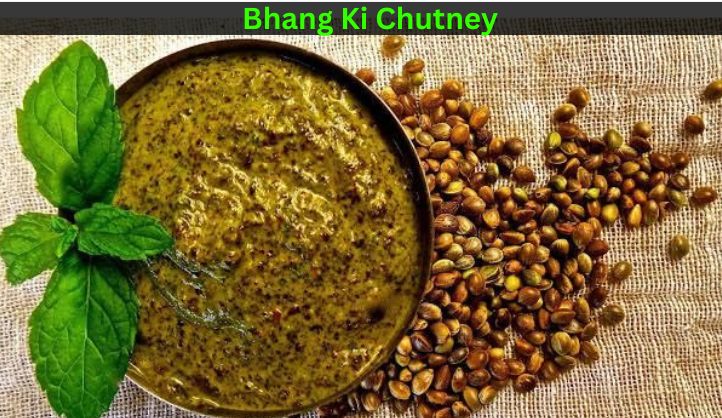Bhang ki chutney, a specialty from the उत्तराखंड (Uttarakhand) region of India, is a flavorful condiment that goes beyond its name. Unlike its association with intoxicating beverages, this chutney uses hemp seeds (bhang ke beej) for a delicious and nutritious accompaniment to various dishes.
A Powerhouse of Goodness
Hemp seeds, the star ingredient of bhang ki chutney, are packed with nutrients. They are a rich source of protein, fiber, omega-3 and omega-6 fatty acids, making them a wholesome addition to your diet. These tiny seeds boast a nutty flavor that forms the base of this unique chutney.
The Art of Making Bhang Ki Chutney
The beauty of bhang ki chutney lies in its simplicity. Here’s a glimpse into the process:
-
Roasting the Seeds: The first step involves dry roasting the hemp seeds in a pan until they turn golden brown. This enhances their flavor and aroma.
-
Grinding the Ingredients: Traditionally, a mortar and pestle (sil batta) is used to grind the roasted seeds with fresh coriander leaves, green chilies, ginger, and a touch of salt. This method allows for a coarser texture, releasing the distinct flavors of each ingredient. However, a blender can be used for convenience.
-
Adding a Twist (Optional): Some recipes incorporate additional elements like mint leaves or a dash of sugar for a more nuanced taste.
Enjoying Bhang Ki Chutney
Bhang ki chutney’s versatility makes it a perfect companion for various dishes.
- As a Dip: Enjoy it with crudités, crackers, or even alongside samosas for a burst of flavor.
- With Curries and Dals: It adds a delicious depth to lentil curries and vegetable dals, complementing the earthy flavors.
- Rice and Roti Companion: A dollop of bhang ki chutney alongside rice or roti elevates your everyday meals.
Beyond the Plate
Bhang ki chutney is not just about taste. It’s believed to have some health benefits. Hemp seeds are known for their anti-inflammatory properties and potential to improve digestion. Additionally, the chutney’s fresh ingredients provide essential vitamins and minerals.
Variations and Regional Twists
Bhang ki chutney, while rooted in simplicity, offers room for exploration. Here’s a look at some interesting variations and regional twists:
-
Spicy Affair – For those who love a kick, adding more green chilies or a sprinkle of red chili powder during roasting can elevate the spice quotient.
-
Aromatic Adventure – For an extra layer of aroma, some recipes suggest toasting the hemp seeds with a few cumin seeds or a bay leaf before grinding.
-
Coconut Connection – In some regions, a touch of grated coconut is added to the chutney for a creamier texture and a hint of sweetness.
-
Tangy Twist – A squeeze of tamarind or raw mango can introduce a delightful tanginess to the chutney, balancing the nutty flavor profile.
-
The Seasonal Touch – Fresh seasonal ingredients like chopped tomatoes or roasted pumpkin seeds can be incorporated for a burst of color and additional nutrients.
Beyond Uttarakhand
While bhang ki chutney is a staple in Uttarakhand, variations of this hemp seed chutney exist in other parts of India.
-
Maharashtrian Hemp Seed Chutney – In Maharashtra, a similar chutney is made with roasted hemp seeds, peanuts, and fresh coriander leaves. This version often features a coarser grind and a stronger peanut flavor.
-
South Indian Hemp Seed Chutney – South India has its own take on the hemp seed chutney, sometimes incorporating ingredients like curry leaves, grated coconut, and a touch of jaggery for a sweet and savory balance.
Some other dishes of Uttarakhand
-
Kafuli/Kaapa – This dish is considered the most popular food in Uttarakhand and is a staple in Pahari cuisine. Made with spinach, lai (mustard greens), and fenugreek leaves, Kafuli is a delicious, light, and healthy curry. It is cooked in an iron kadhai (wok) and eaten with gravy made from rice or wheat paste and water. Kafuli is a winter dish, as mustard greens and fenugreek are at their seasonal best during this time.
-
Phaanu – This protein-rich dish is a staple in Garhwali cuisine. Made with black gram lentil paste (black urad dal) and rajma (kidney beans), Phaanu is slow-cooked with a blend of spices, resulting in a thick and flavorful curry. It is often served with rice or roti.
-
Baadi – Another protein-rich dish from the Garhwal region, Baadi is made with lentils like gahat (moth beans) or bhatt (black gram) that are ground into a paste. The paste is then steamed in leaves and shaped into patties. Baadi can be enjoyed on its own or stir-fried with vegetables.
-
Aloo Tamatar Ka Jhol – This simple yet flavorful dish is a comfort food in many households of Uttarakhand. Made with potatoes (aloo), tomatoes (tamatar), and a basic spice blend, Aloo Ka Jholis a quick and easy curry perfect for a weeknight meal. It is typically served with rice or roti.
-
Chainsoo – This stir-fried dish is a specialty of the Kumaon region. Made with colocasia leaves (also known as taro leaves), Chainsoo is a flavorful and healthy side dish. The colocasia leaves are stir-fried with spices and sometimes include other vegetables like potatoes or green beans.
-
Dubuk – A popular dish in the Kumaon region, Dubuk is a lentil stew made with black gram (urad dal). The lentils are cooked with a variety of vegetables like tomatoes, onions, and green chilies, and flavored with a blend of spices. Dubuk is a hearty and satisfying dish, perfect for a cold winter day.
-
Jhangora Ki Kheer – No meal is complete without dessert, and Jhangora Ki Kheer is a delicious and nutritious option from Uttarakhand. Made with jhangora (barnyard millet), a grain indigenous to the high altitudes of the state, this kheer is cooked with milk, sugar, and nuts. The result is a creamy and flavorful pudding that is perfect for satisfying your sweet tooth.
A Celebration of Local Ingredients
The beauty of bhang ki chutney lies in its celebration of local ingredients. Hemp seeds, readily available in the region, are transformed into a delicious and nutritious condiment. This chutney serves as a reminder of the rich culinary heritage of Uttarakhand and the creativity that emerges from using locally sourced ingredients.
FAQs About Bhang Ki Chutney
1. What are the main ingredients in Bhang Ki Chutney?
- Hemp seeds (bhang ke beej)
- Fresh coriander leaves
- Green chilies
- Salt
- Lemon juice (sometimes)
2. Are there any substitutes for hemp seeds?
While hemp seeds are the key ingredient, you can substitute them with peanuts or sunflower seeds for a similar taste and texture. However, the nutritional profile will differ.
3. How can I adjust the spice level of Bhang Ki Chutney?
- Use fewer green chilies for a milder chutney.
- Add more chilies or a pinch of red chili powder for a spicier version.
4. What is the best way to grind Bhang Ki Chutney?
- Traditionally, a mortar and pestle (sil batta) is used for a coarser texture.
- A blender works well too, but be careful not to over-blend as it can make the chutney too smooth.
5. Does Bhang Ki Chutney have any health benefits?
Hemp seeds are a good source of protein, fiber, omega-3 and omega-6 fatty acids, and may have anti-inflammatory properties and aid digestion. However, consult a healthcare professional for specific advice.
6. Can I make Bhang Ki Chutney without coriander leaves?
Yes, you can omit coriander leaves or substitute them with mint leaves for a slightly different flavor profile.





